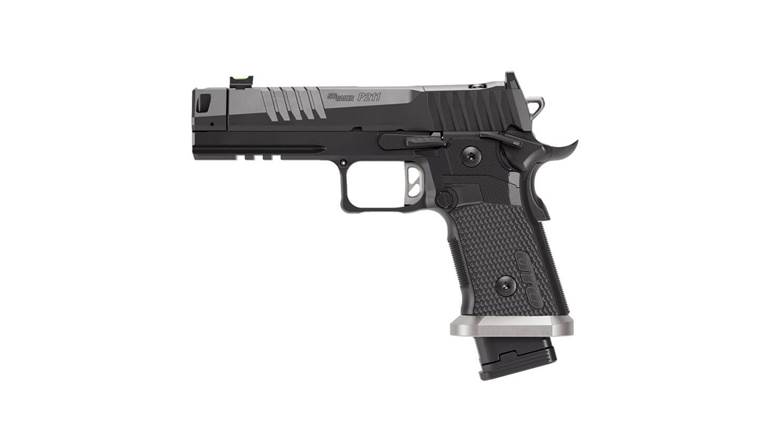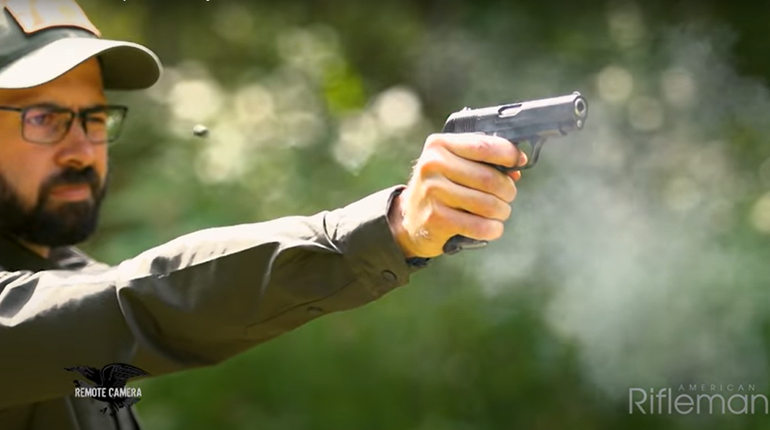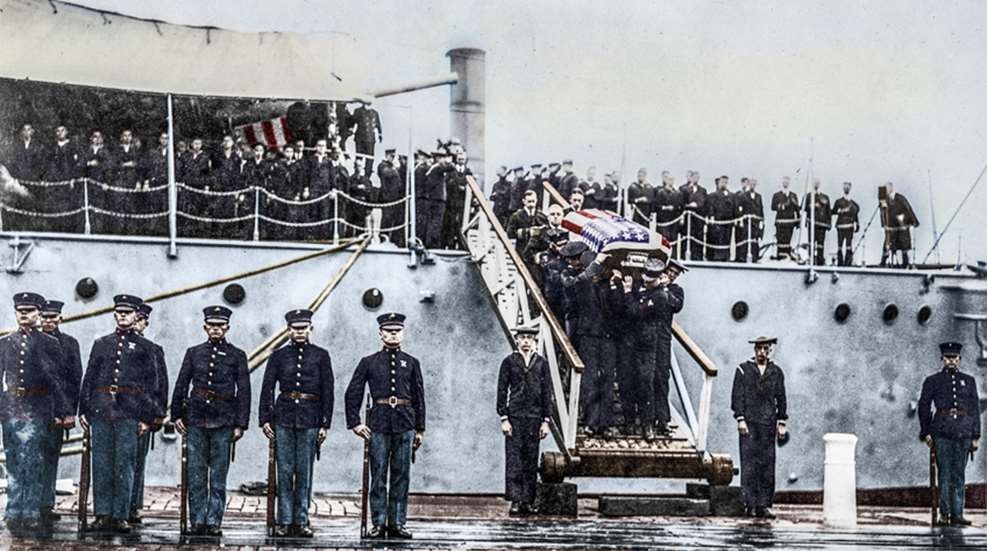
Guarding the Tomb of the Unknown Soldier
Sentinels at the Tomb of the Unknown Soldier recently received new SIG Sauer U.S. M17 pistols inlaid with wood from the U.S.S. Olympia. It was selected because she was the honored ship that transported the remains of the World War I Unknown Soldier home from Europe. Today, three American soldiers are interred at the Tomb, one each from World War I, World War II and Korea. (A fourth unknown from the battlefields of Vietnam was later identified and returned to his family). 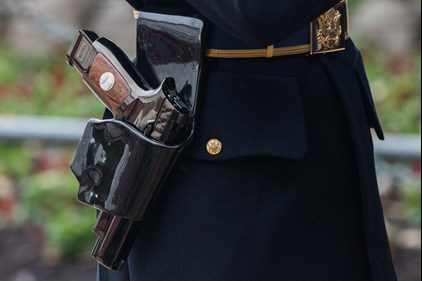
Aboard the U.S.S. Olympia, a young U.S. Marine Corps captain led the Honor Guard that accompanied the remains of Unknown Soldier back home in 1921—the year the Tomb was dedicated. His name was Graves Erskine.
General Graves B. Erskine, USMC 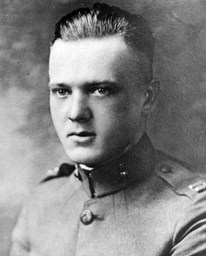
Graves Blanchard Erskine was born in Columbia, La., on June 28, 1897. On April 6, 1917, the United States declared war against Germany. Little more than a month later on May 22, 1917, Erskine was commissioned as a second lieutenant in the Marine Corps. He was 19 and had just completed his degree at Louisiana State University. Like so many young men, Erskine joined the military to fight for his country in what would become known as World War I.
Erskine wrote about his Marine Corps officer training in his diaries, which can be found at Quantico, Va. At Quantico, Lt. Erskine had a “jolly good time firing the Springfield about five hours each day.” Erskine also shared that he learned to be a “hard boiled Marine” while training in the “sultry Virginia climate.”
Training soon ended and Lt. Erskine departed Quantico on Jan. 18, 1918, for St. Nazarine, France with the 6th Marine Regiment, commanded by Col. Albertus Catlin, a survivor of the explosion aboard the U.S.S. Maine in 1898. As with thousands of other soldiers and Marines, Erskine was not fond of the crossing aboard the troop ship. He shared in his notes, “I was not seasick but was sick of my trip before it was finished.”
Erskine arrive in St. Nazarine on Feb. 7, 1918. He and his fellow Marines were greeted by joyous French citizens shouting “Vive l’Amerique!” The French had been embroiled in a costly war, with more than 1,000,000 French soldiers killed between August 1914 and January 1918.
He wrote, on June 6, 1918, while at Bouresches, France: “[It] was my first trip over the top in a battle formation. We gained the tower but had a hell of a time and held against several counter attacks.” The Bouresches fight was part of the Battle of Belleau Wood, a month-long counter-offensive that successfully pushed the Germans back across the Marne. The Marine Corps suffered 4,000 casualties, including 1,000 killed in action, the heaviest losses of the Corps’ history to that point.
On July 15, 1918, an exploding shell took Lt. Erskine out of the war. Nine surgeries and nearly a year in hospital later, he remarked “you can’t die [at a Navy hospital] with the good nurses who are ‘pals’ to all Marines.” For his actions in Belleau Wood, Erskine was awarded the Silver Star.
On Nov. 11, 1918, while recuperating at the Naval Hospital Norfolk, Va., the Great War ended. Erskine wrote in his diary, “[T]he day was certainly one of joy but I could not realize the reason for all of it.” By that date, in just over 16 months since America joined the fight, “The War to End All Wars” saw more than 200,000 Americans wounded and more than 116,000 killed, many of whom were unidentifiable. Erskine fully recovered from his wounds and remained on active duty in the Marine Corps.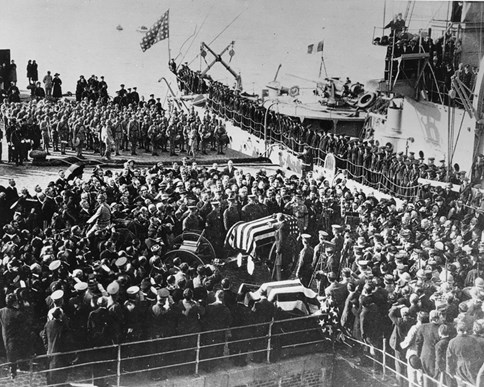
In March 1921, Congress approved the burial of an unidentified American soldier from World War I at Arlington National Cemetery. The U.S.S. Olympia was selected to transport the remains of this Unknown back home from France. The famous cruiser steamed from Philadelphia on Oct. 3, 1921, with an honor guard of sailors and Marines led by Capt. Erskine aboard.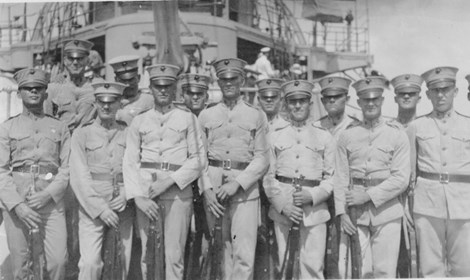
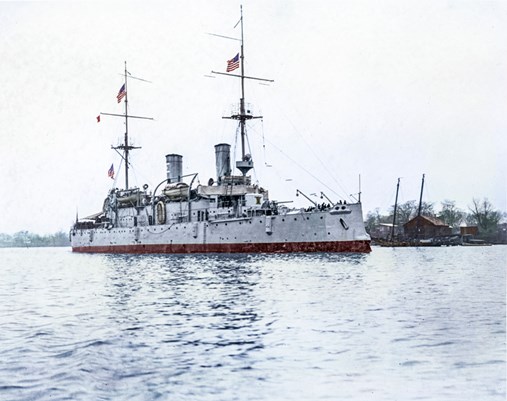
In France, Army Sgt. Edward F. Younger placed a white rose atop the coffin of the remains of an unidentified serviceman from one of the battlefields where so many had perished. This would be the Unknown that Olympia brought home, representing all unknowns lost in the war.
For two weeks, as the U.S.S. Olympia transited the Atlantic Ocean, Capt. Erskine and his honor guard stood watch. In rough autumn seas, these were long, difficult, and lonely hours, filled with memories of friendships forged by battle and brothers lost to war.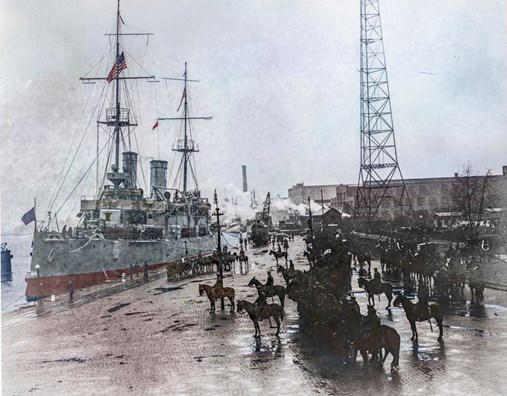
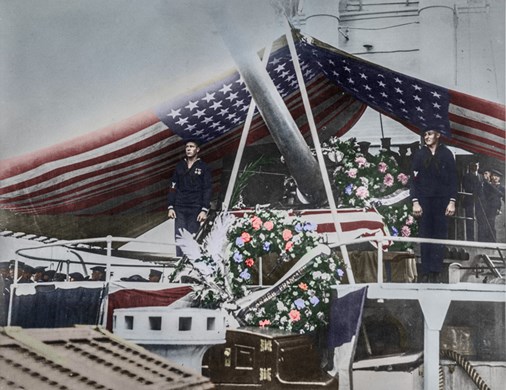
On Nov. 9, 1921, the U.S.S. Olympia arrived at the Washington Navy Yard. She was greeted by Secretary of War John W. Weeks, Secretary of the Navy Edwin Denby, and Gen. John J. Pershing. The gangway was lifted to the U.S.S. Olympia’s fantail. The Marine Corps honor guard and Olympia’s band then departed the ship. 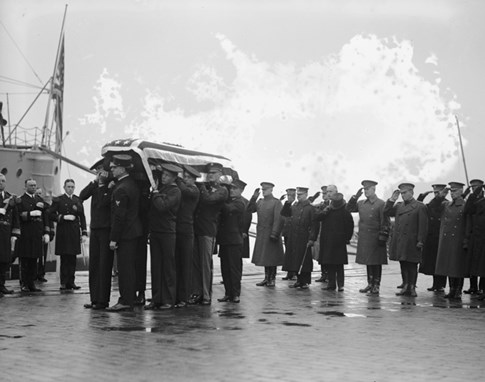
The Unknown Soldier was carried over the side by Navy sailors, chief petty officers and Marines, then placed on a caisson. Eight decorated World War I veterans were hand-picked by Gen. Pershing to be pallbearers, including five soldiers, two sailors and one Marine. The pallbearers were led by Medal of Honor recipient Army Sgt. Samuel Woodfill, who accompanied the Unknown Soldier to the U.S. Capitol, where he laid in state for two days. President Warren G. Harding pinned a shield of the United States to the flag covering the coffin. Supreme Court Chief Justice William Howard Taft presented a wreath of chrysanthemums."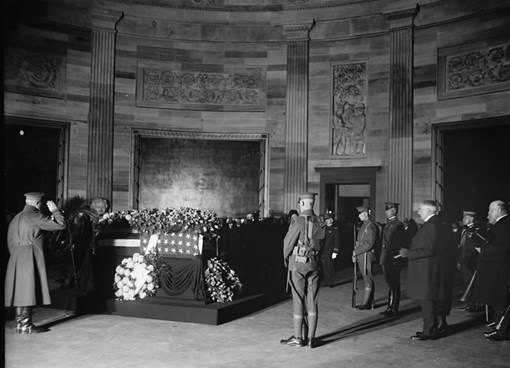
On Nov. 11, 1921, the Unknown Soldier was transported to Arlington National Cemetery for final burial. He was escorted by President Harding, Gen. Pershing, Vice President Coolidge, Chief Justice Taft, and members of the House of Representatives and the Senate, on foot. Former President and Mrs. Wilson also attended the ceremony.
President Harding awarded the Unknown the Medal of Honor and the Distinguished Service Cross. American Indian Chief Plenty Coos decorated the Unknown with his feathered war-bonnet. From that day forth, the Tomb of the Unknown Soldier would be an honored resting place for all fallen service members “Known But To God.”
Erskine remained on active duty in the 1920s and 1930s. On Dec. 8, 1941, the United States declared war on Japan, and three days later we were also at war with Germany. Colonel Erskine quickly became charged with amphibious operations in the Pacific. As brigadier general, he planned and executed the landings on the Marshall Islands, Saipan, and Tinian. Major General Erskine was made the commander of the 3rd Marine Division and led the battle of Iwo Jima in February 1945. That August, Japan surrendered. 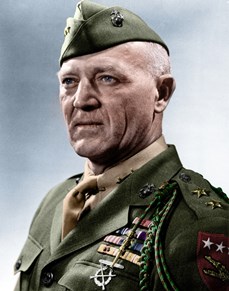
After serving in his second World War, Gen. Erskine held several high positions, including commander of Camp Pendleton, the 1st Marine Division, and he became the Commanding General Fleet Marine Force Atlantic. General Erskine retired from active duty in June 1953, having served as a Marine officer for 36 years. He didn’t retire to the golf course, though. Based on a special act of Congress, Gen. Erskine became an aide to the Secretary of Defense as the Director of Special Operations.
In this role, he attended a very special ceremony on May 30, 1958—the internment of the World War II and Korean War Unknown Soldiers at Arlington National Cemetery. President Eisenhower spoke at the event, and the Army Chorus sang “Dirge for Two Veterans.” A copy of the Department of Defense program for the ceremony can be found in General Erskine’s papers at Quantico, however, there is no written account of the emotions he felt that day. General Erskine accompanied the World War I Unknown home from Europe in 1921, and 37 years later he helped two more fallen soldiers be laid to rest in hallowed home soil.
General Erskine died on May 21, 1973, and he is interred at Arlington National Cemetery. He now eternally rests with those brave souls that he served with, and the Unknown Soldier that he stood watch over so many years ago.
M17s on Duty
In October 2018, a ceremony was held at Arlington National Cemetery to commemorate the four new sidearms that would be carried by the Sentinels guarding the Tomb of the Unknown Soldier. The SIG Sauer-made U.S. M7 pistols are specifically inlaid with wood from the deck of U.S.S. Olympia and include the crest of the U.S. 3rd Infantry Regiment, The Old Guard. 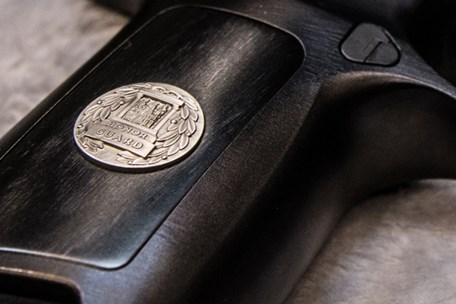
These new M17s are 9x19 mm, striker-fired pistols with a non-railed aluminum receivers, stainless-steel slides, wood grip inserts, 21-round magazines, “XXI” slide serrations, and features the same optic cut as specified by the MHS contract. The iron sight dots are made from marble dust from the Tomb of the Unknown: Tritium vials normally installed in the M17 were replaced with marble dust suspended in glass. This marble dust was recovered by Sentinels when the crypt cover for the Vietnam Unknown was re-inscribed: “Honoring and Keeping Faith with America’s Missing Servicemen.”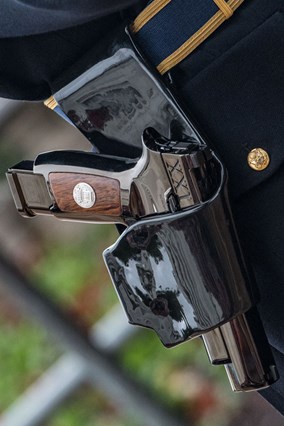
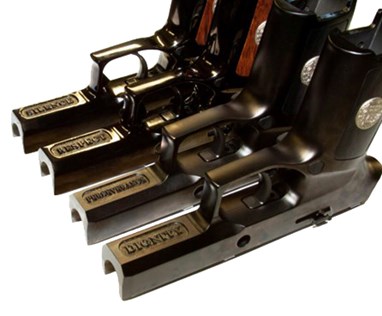
Two pistols engraved with the names “Silence” and “Respect” have a high-polish finish, bearing the wood stocks from deck of the U.S.S. Olympia. The second pair of pistols, “Dignity” and “Perseverance,” have matte finishes, use black laminate grip inserts and are designed for inclement weather—a necessity for the constant 24-hour vigil, in good weather or bad, while the Tomb Sentinels stand guard.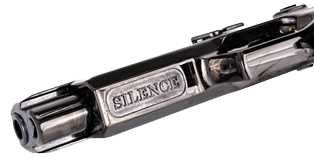
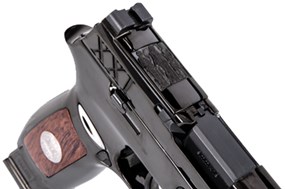
“Dignity” and “Perseverance” represent The Sentinel’s Creed. “Silence” and “Respect” represent the request to the public by Arlington National Cemetery when visiting the Tomb of the Unknown Soldier, and during the Changing of the Guard.
The engraved “XXI” slide serrations as well as the 21-round magazine capacity, signify the twenty-one precise steps that Tomb Sentinels walk, and the honored 21 Gun Salute. The sight plate is engraved with impression of the Greek Figures featured on the east panel of the Tomb--Peace, Victory, and Valor.
The Honored Ship: U.S.S. Olympia
When the U.S.S. Olympia sailed out of San Francisco on her maiden voyage in 1895, the United States was not a superpower. The country was still recovering from the Civil War, Great Britain and Spain ruled the seas. Within a few short years, the U.S.S. Olympia led the charge to launch the nations as a world power.
The U.S.S. Olympia served as Commodore George Dewey’s flagship at the Battle of Manila Bay, May 1, 1898. After a decisive victory over imperial Spain, the U.S.S. Olympia and Dewey were celebrated together as living heroes. Admiral Dewey was quickly promoted to Admiral of the Navy, and still holds the recognition of being the highest-ranking U.S. Navy officer in American history.
The U.S.S. Olympia continued her career well into the 20th century. She was later the flagship of the North Atlantic, protecting convoys during World War I. In 1918, she landed troops in northern Russia to help push back the Bolshevik Revolution, and deployed doctors and nurses to Europe during the Spanish Flu epidemic of 1919. As the training vessel of the U.S. Naval Academy in Annapolis, Md., she helped instruct hundreds of young leaders. Among them was Midshipman Franklin Van Valkenburgh; who later was posthumously awarded the Medal of Honor for sacrificing his own life as the commander of the U.S.S. Arizona at Pearl Harbor.
The U.S.S. Olympia heralded an era of speed, tactical efficiency and engineering ingenuity that turned the United States into a world naval power. As such, she was chosen to bring home the remains of the Unknown Soldier. After 27 years of honored service, the U.S.S. Olympia was retired to the Philadelphia Navy Yard in 1922.
Giants among men like Admiral Dewey, Gen. Erskine and President Theodore Roosevelt walked her decks; the same decks still aboard her today as a museum ship in Philadelphia. As an Olympia volunteer and member of her board of directors, I am very proud that pieces of Olympia continue to protect the Unknown Soldier and the Sentinels that have devoted their service to honor all of the fallen Unknown. 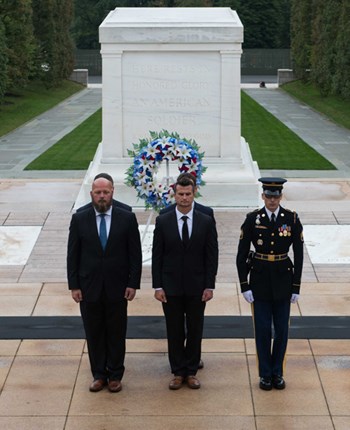
The Tomb of the Unknown Soldier is an honored and moving place on hallowed ground, and I highly recommend visiting at Arlington National Cemetery. Just a few hours away, the Flagship Olympia is berthed on the Delaware River, at Penn’s Landing, Philadelphia, Pa. As part of the Independence Seaport Museum, she is open to the public year-round. Be a part of history; visit, explore, learn, and donate to the Flagship Olympia, at FlagshipOlympia.org.
Images by author and courtesy Flagship Olympia Foundation
Official Marine Corps photos courtesy of the Marine Corps History Division
Additional Reading:
in the Company of Soldiers: The U.S. M17 & M18 Modular Handgun Systems
M1152 & M1153: The Army's New 9 mm Luger Loads
Tested: SIG Sauer P320 M17 Pistol













